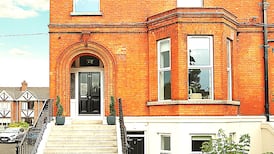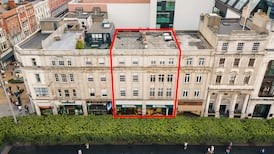Offices Industrial: Dublin's south docklands led the way as a depressed office market recovered late in 2004 - and agents are upbeat about the year to come, reports Dick Ahlstrom
The office sector remained somewhat depressed during 2004, but the patient has shown recent signs of recovery. The vacancy rate remained stubbornly high at 14 per cent overall, but centres such as Dublin rebounded later in the year.
Suburban lettings remain a matter of concern however, with the buyer's market ensuring that inducements are always there for the taking. Overall, agents are being decidedly upbeat about the year, focusing on the later upturn.
The suggestion is that the bounce will continue through 2005 and the slack period will end. The view generally is this is not an Irish phenomenon but a trend seen across the wider European office sector.
The Dublin market led the charge with complete results for the first nine months of 2004 suggesting a total take-up of 119,624 sq m (1.2 million sq ft). This compares to 103,609 sq m (1.115 million sq ft) for the same period in 2003.
CB Richard Ellis Gunne's director of research, Ms Marie Hunt, believes that the push will be sustained through the end of the year bringing take-up as high as 150,000 sq m (1.614 million sq ft) let in the capital. In this, Dublin 2 and 4 were the strongest with vacancy rates at 7.4 per cent - about half the average seen elsewhere.
Prime rents remained stable at about €485 per sq m (€45 per sq ft) during the year, but the late growth in demand began to depress the inducements being offered for city properties. Prime yields generally were also depressed to about 5.25 per cent.
Of the 205,000 sq m (2.2 million sq ft) of current office demand recorded after the first nine months of 2004, about 10 per cent of this was IFSC companies looking to relocate.
There was about 55,000 sq m (592,014 sq ft) of new office supply due to be completed by year end 2004.
The Barrow Street/Docklands area of Dublin 4 was a particular focus of activity. Mason Hayes and Curran Solicitors agreed to take 5,575 sq m (60,008 sq ft) on Barrow Street while Google took about 6,320 sq m (68,027 sq ft) in The Gasworks development.
Speculative development also continues, an example being Zoe development's decision to go with an 18,500 sq m (199,132 sq ft) development in Barrow Street. And Mountbrook Homes paid about €35 million for the Riverside site in the docklands. O2 signed a long lease on about 9,940 sq m (106,993 sq ft) at Sir John Rogerson's Quay in Dublin 2 .
Pre-lettings also boosted the Dublin market, an example being Independent Newspapers, which signed a lease for its new 4,646 sq m (50,009 sq ft) headquarters building in Talbot Street, Dublin 1.
There are also a number of Dublin 2/4 active requirements, examples including Pfizer (6,500 sq m - 69,965 sq ft)), Matheson Ormsby Prentice Solicitors (9,290 sq m - 99,996 sq ft)) and others seeking between 5,000-9,290 sq m (53,819-99,996 sq ft).
The great schism, city versus suburban, remains with more demand and higher rents available in cities. Yet here too there are signs that things are improving. In Dublin the Luas is being congratulated - or blamed- for this resurgence in the areas it serves, principally Sandyford, but also along the Red Line to Tallaght.
Inducements continue to form part of all deals in these suburban locations. However, with signs of recovery, they are much slower coming. This phenomenon has encouraged some developers holding planning permits for offices, to reapply for high density apartment complexes for sites anywhere near Luas stations. A notable example is the former MJ Flood site in Sandyford.
The south suburbs outpaced other suburban areas during 2004. Collective 2004 activity to the end of Q3 showed that the majority of lettings, 35 per cent, were in the south suburbs. Overall suburban vacancy stood at 15.75 per cent, but the south had a more favourable rate of 10.2 per cent.
North and west suburbs had a take-up of about 15,000 sq m (161,458 sq ft) by the end of October, small compared to other parts of the city.
The largest deals continue to be done in the south Dublin suburbs, examples including Dell's move into Cherrywood in a deal involving 12,000 sq m (129,166 sq ft) for more than €200 per sq m (€18.58 per sq ft). It involves a closure of its existing Bray facility. Merck Sharpe & Dohme also signed a lease on 2,475 sq m (26,640 sq ft) at Pelham House in Sandyford.
The senior surveyor in the office department at CB Richard Ellis Gunne, Robert Colleran, is decidedly upbeat about the sector. "It is back on top in terms of the actual numbers of deals that have closed. There is a lot of space reserved and ready to go." He cites, but doesn't name, a 12,000 sq m (129,166 sq ft) deal under negotiation and expected to close within the fortnight as an example. There had been considerable interest in the Grand Canal Docks and Barrow Street in particular.
"There have been a lot of tenants moving out of the IFSC to the south docks," he says. "A lot of the office occupiers are looking for deals now while they can get them." As the market strengthens into the new year it will cause the number and quality of inducements offered to fall back. While 18 months of free rent or the full fit-out of space is being offered to tenants now, these will not be on the table as we move into 2005, Mr Colleran believes.
"There still are deals to be done but in the next six to 12 months they will not be available." This in turn is causing a degree of churning on the market as occupiers look for better value.
The IFSC costs about €600 per sq m (€55.74 per sq ft) at the moment, while new deals on the south docks tend to range about €475 per sq m (€44.12 per sq ft), he says. Away from these prime areas prices are more in the €375 per sq m (€34.83 per sq ft) range.
Other urban centres see nothing like these rents, he adds. Galway rentals are often in the €105-€110 per sq m (€9.75-€10.21 per sq ft) range. "Dublin is at the top of the market at the moment."
The picture isn't so rosy in suburban areas, particularly outside Dublin where significant overhang has depressed prices and there is too much space available. The Luas phenomenon is beginning to have an impact however, Mr Colleran believes.
"The introduction of the Luas lines has helped things. We have already seen this around Sandyford and it is starting to take effect on the Tallaght Red Line," he stated. "Demand for office space has grown more strongly near the Luas stations." This is true even in areas close to central Dublin, for example Smithfield and environs.
Mr Colleran does not see the Government's decentralisation programme having any serious effect on the market, at least not for the present. Most of the moves take place in several years. "It hasn't had any impact on the market at the moment."
Declan O'Reilly, a director at H T Meagher O'Reilly, has also noted the improved situation. "Overall there is a kind of a general air of optimism coming to the end of the year that wasn't there 12 months ago," he says.
The Georgian market reflects this he suggests. "Pricing in that sector of the market has started to move upwards." The "to let" signs around Dublin's Georgian squares have finally started to disappear.
"There has been a lot of activity in the pre-let market, particularly in the south docks," he suggests. "These deals won't impact on the take-up figures for perhaps 18 months," he says but they do help market sentiment. "They have been confidence boosters." Urban markets are stronger than suburban. "Out of town is still a challenge," he acknowledges. The result in the cities is that inducements are evaporating.
While north and west suburbs with a few exceptions, for example the Kelloggs deal in north Dublin, are slow, Sandyford has started to improve, he says. "Sandyford has picked up and it is a direct link to the Luas and the M50."
Thomas Carthy, the partner in charge of the office sector at Harrington Bannon, concurs with this positive view. "The outlook is very good for 2005," he says, coming off the back of an improving 2004. "There is no doubt the office market is improving quite significantly in my opinion.
"We have been buying buildings over the past 18 months to bring them through next year." There are a number of major deals in the pipeline and this is being bolstered by "people known to be on the market" for office accommodation.
He too sees a return of speculative building in the sector, examples being the redevelopment of 1 and 2 Hatch Street and the south docks.










